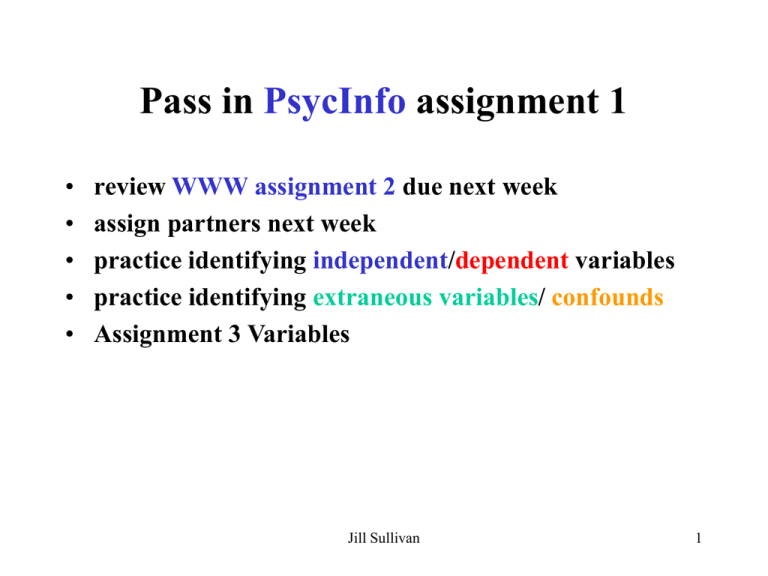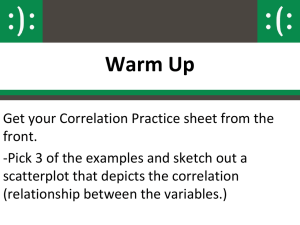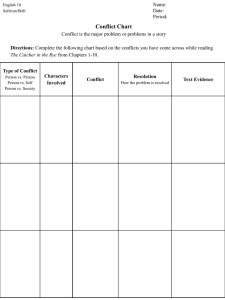
Pass in PsycInfo assignment 1
•
•
•
•
•
review WWW assignment 2 due next week
assign partners next week
practice identifying independent/dependent variables
practice identifying extraneous variables/ confounds
Assignment 3 Variables
Jill Sullivan
1
IV/DV/Extraneous/Confound
Independent Variable: variables controlled by the
experimenter in an attempt to test the effects on some
outcome, the dependent variable
-variable that is manipulated by the experimenter. It is
determined by the experimenter not the participant
Quasi-independent: existing quality, levels not assigned at
random (ie. Age)
Dependent Variable: variable measured in a study. It is
determined by the subject.
-The outcome variable of research
-dependent variable observed for effects due to the influence
of another factor , the IVJill Sullivan
2
IV’s and DV’s
Independent Variable:
• the variable which is manipulated by the experimenter
• under the control of exp. (ie,. Independent of participants
behaviour)
The set values or conditions of the IV are called the levels
ie. Interested in sleep deprivation and motor skills
• decide to have 3 levels:
– 12 hours without sleep
– 24 hours
– 36 hours
Jill Sullivan
3
IV/ DV
Example 1
ie. Interested in sleep deprivation and motor skills
• decide to have 3 levels:
– 12 hours without sleep
– 24 hours
– 36 hours
Then you measure participants on a hand/eye coordination task
DV: score on coordination task
Jill Sullivan
4
Identify IV (levels) and DV
Example 2
You’re interested in conducting a true experimental study to
determine whether people are more satisfied after they
succeed at an easy or a difficult task
IV: task difficulty
• # levels: 2; easy/hard
DV: satisfaction
Jill Sullivan
5
EXAMPLE 3
A Researcher conducts an experiment to determine the
effect of a new drug on the incidence of epileptic seizures.
40 epileptics are selected from the 150 epileptics being
treated at a local hospital. 20 receive the new drug and 20
are given their traditional medication. The number of
seizures in each of the participants is recorded for one
month.
IV:
• type of medication
# Levels of IV?
• 2
• new drug, traditional drug
DV:
• number of seizures
Jill Sullivan
6
IV: manipulated by experimenter
DV: what is measured and recorded
A Researcher conducts an experiment to determine the
effect of a new drug on the incidence of epileptic seizures.
40 epileptics are selected from the 150 epileptics being
treated at a local hospital. 20 receive the new drug and 20
are given their traditional medication. The number of
seizures in each of the participants is recorded for one
month
Jill Sullivan
7
Example 4
A researcher is interested in testing the effectiveness of
type of reading program on children’s reading skills.
Children are assigned to either a tutoring, tutoring and
rewards, or no tutoring and no rewards group. Reading
scores are recorded after two weeks time.
IV: type of reading program
• 3 Levels
– tutoring
– tutoring and rewards
– no tutoring and no reward
DV: reading score
Jill Sullivan
8
IV/DV- Example 5
Would you take a drink of water from a fountain if someone were sitting right
next to it? In an experiment investigating participants’ willingness to violate
personal space, Barefoot, Hoople and McClay (1972) positioned a male or
female experimenter near a water fountain. The experimenter was positioned
either one foot (near condition), five feet (far condition) to the right of the
fountain, or across from the fountain, ten feet away (control condition). The
number of people passing the fountain was recorded along with how long a
person spent at the fountain if he or she chose to drink. The results showed
that fewer participants drank from the fountain in the near condition than in
the far or control conditions.
IV: 1) distance the experimenter sat from the water fountain
• levels (one foot, five feet, or 10 feet)
2) sex of experimenter 2 levels (male or female)
DV: 1) number of people who stopped to drink
2) amount of time spent at the fountain
Jill Sullivan
9
Extraneous Variables / Confounds
Unjustified Conclusions
Extraneous Variables : any factors other than the independent
or quasi-independent variables you’re considering that
might affect scores on the dependent variable. (ie, age,
noise)
Confounds; A confound or a confounding variable is an
extraneous variable which varies systematically with your
independent variable. It provides an alternative explanation
for your results over and above your manipulation of the
IV. (ie. A difference between conditions or groups other
than what was intended).
Other problems; poor measurement of constructs, unjustified
causal inferences
Jill Sullivan
10
Uncontrolled Variables
Example 1
An experimenter wanted to test the effects of music on learning by
fourth grade children. To keep his work at a manageable level, he
decided to introduce music into the classroom every afternoon for one
week. No music would be played during the morning hours. The
experimenter chose the music carefully, the music was from familiar tv
cartoons, and the loudness was moderate. After the week of music
presentation, the students were given tests on the morning and
afternoon material. Test scores for the morning material were much
higher than the scores on the afternoon material. Thus, the
experimenter concluded that cartoon music disrupted learning in the
classroom.
• Is the conclusion justified? Why or why not?
• No,
• Confound present : music played only in afternoon. Time of day may
account for higher test scores
Jill Sullivan
11
Uncontrolled Variables
Unjustified Conclusions
More examples
Data: Fifty percent of women who take birth control pills
have occasional hot flashes. Men almost never have hot
flashes.
Conclusion: Birth control pills cause hot flashes
Conclusion justified?
No. Why not?
Correlation doesn’t prove causation. Hot flashes may occur
in women even if they don’t take birth control pills.
Jill Sullivan
12
Uncontrolled Variables -Example 2
An experiment was designed to evaluate the effect of
“subliminal perception” on thirst. The participants
(university students) were randomly assigned to two
groups. One group watched a movie (Return of the Pink
Panther) that did not contain subliminal messages. The
other group watched a movie (The Desert Fox) in which
the message “Have a cool drink!” was repeatedly flashed
on the screen so quickly that it was not consciously
noticeable. Because of time limitations, the first group
watched the movie at 8:30am, the second at 11:30am. The
dependent measure was the amount of ice water consumed
by the participants as they watched the movie. The second
group drank significantly more ice water than the first;
therefore, the researchers concluded that subliminal
messages can affect thirst.
Jill Sullivan
13
Uncontrolled Variables -Example 2
Agree with their conclusion?
No. Why not? What’s the problem?
-2 confounds present:
time of day; people may be thirstier at 8:30 than 11:30
movie used: “Desert Fox” Has a dry connotation as opposed
to “Pink Panther” , amount of water drank may be due to
the movie not the subliminal message.
Jill Sullivan
14
Another Example
A researcher wants to examine the relation between personality and
health habits. The researcher believes that people who have low selfesteem will be more likely to have unhealthy habits (e.g. smoking,
overeating, poor dental hygiene). To conduct the research, the
researcher distributes two questionnaires to all students currently
enrolled in Introductory Psychology courses. The first questionnaire is
a personality inventory that measures self-esteem. The second
questionnaire is a survey of the person’s health habits. The researcher
examines the data and concludes that self-esteem and unhealthy habits
are related in this sample: those with lower self-esteem tend to engage
in more risky personal health behaviours than those with higher selfesteem.
Jill Sullivan
15
• Any problems with this conclusion?
• Unjustified, why?
• Number of other factors left unexamined (extraneous
variables) which could account for both low self-esteem
and personal health behaviours
– background
– income
– many plausible answers
• another extraneous variable: intro psyc students may differ
in some manner than general population (external validity)
Jill Sullivan
16
Uncontrolled Variables
Example
An employee at a certain cafeteria wanted to show his boss that the
policy of serving “exotic” juices with breakfast (if the customer
requested it) was a wasteful practice. He thought people just
bought the exotic juices to impress their friends and that they did
not really like the taste of the juices. In order to gather evidence,
the man recorded the flavour of the juice contained in the glasses
of those patrons who failed to drink all of their juice. At the end of
the morning he had counted a total of fifty less than completely
finished glasses of juice. Of these, forty were of the exotic variety
and only ten were of the non-exotic variety (orange juice). Because
80 % were of the unfinished juices were of the exotic variety, the
employee concluded that his evidence was sure to convince his
boss. Do you agree?
No…… Why not?
Unjustified conclusion; wrong adjustment made, need to adjust for
#’s of each type of juice ordered, perhaps 200 people ordered
exotic juices and 40 left unfinished, compared to 50 nonexotic and
Jill Sullivan
17
10 left unfinished
Practice!
Assignment 3- Variables assignment
• Due in 2 weeks time
• Oct 12 (A) Oct 14 (B/C)
Jill Sullivan
18









